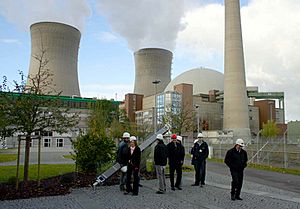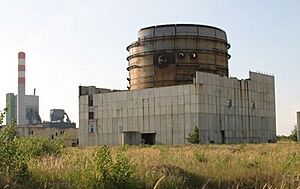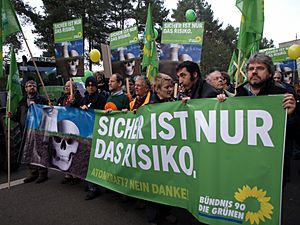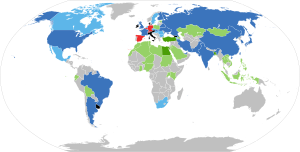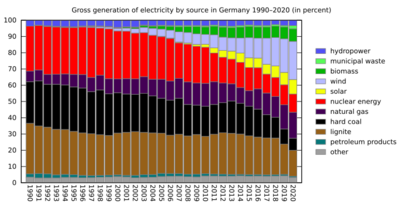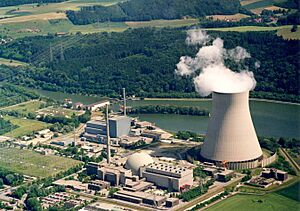Nuclear power in Germany facts for kids
Nuclear power was used in Germany from the 1960s. It was completely stopped in April 2023.
Germany started with research reactors in the 1950s and 1960s. The first power plant for everyday use opened in 1969. By 1990, nuclear power made about a quarter of Germany's electricity.
People in Germany have protested against nuclear power since the 1970s. These protests grew stronger after the Chernobyl disaster in 1986. After the Fukushima nuclear disaster in Japan in 2011, the German government decided to close all its nuclear power plants by 2022. Eight of Germany's 17 working reactors were shut down right after Fukushima.
In 2021, nuclear power made up 13.3% of Germany's electricity. This came from six power plants. Three of these closed at the end of 2021. The last three stopped working by April 2023.
Contents
Germany's Nuclear Journey
Early Discoveries and Research
Before Nazi Germany took over, German universities had many famous nuclear physicists. These included Albert Einstein, Otto Hahn, and Lise Meitner. In 1938, Hahn and his colleague Fritz Straßmann discovered nuclear fission. This was an experiment designed by Lise Meitner. She had to leave Germany because she was Jewish.
Soon, countries began a "race" to use this new technology. They wanted it for military or peaceful uses. Germany's "uranium club" (Uranverein) did not succeed in building a nuclear reactor or a nuclear weapon. They faced problems like disagreements and a lack of resources.
First Nuclear Power Plants
Like many other industrial countries, Germany started developing nuclear power in the late 1950s. A few experimental reactors began working before 1960. An experimental power station opened in Kahl am Main in 1960.
All German nuclear power plants built between 1960 and 1970 were smaller. They have all closed down now. The first almost fully commercial plant, Obrigheim Nuclear Power Plant, started in 1969. It operated until 2005. The first large plants, each making over 1000 MW, were the two units at Biblis Nuclear Power Plant. They opened in 1974 and 1976.
There were plans to build nuclear plants in big cities like West Berlin and Ludwigshafen. But these projects were stopped.
Early Protests and Closures
In the early 1970s, large public protests stopped a nuclear plant from being built at Wyhl. These protests showed how local people could challenge the nuclear industry. They used direct action and peaceful disobedience. The police were accused of using too much force. The success at Wyhl inspired other protests in Germany and beyond.
The Rheinsberg Nuclear Power Plant was East Germany's first nuclear plant. It was experimental and worked from 1966 to 1990. The Greifswald Nuclear Power Plant was the second. It was meant to have eight Russian reactors. The first four started working between 1973 and 1979. Greifswald 5 worked for less than a month before it closed. The other three were never finished.
In 1990, when Germany reunited, all East German nuclear plants closed. This was because of safety concerns. The Stendal Nuclear Power Plant was planned to be Germany's largest. But its construction stopped after reunification. The plant was never completed.
The Decision to Stop Nuclear Power
First Plans to Phase Out
Under Chancellor Gerhard Schröder, the government decided to stop using nuclear power by 2022. But this plan was delayed in 2010 by Chancellor Angela Merkel's government. They wanted to extend the life of the plants by 12 years.
This delay caused many protests. About 50,000 people formed a human chain from Stuttgart to a nearby nuclear plant. On March 12, 2011, 100,000 people protested across Germany.
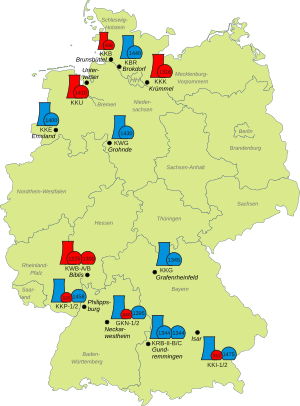
On March 14, 2011, after the Fukushima disaster, Merkel changed her mind. She announced a 3-month pause on extending reactor lifespans. The German company Siemens also announced it would stop working in the nuclear industry. On March 15, the German government said it would temporarily close 8 of its 17 reactors. These were all reactors that started before 1981.
Many people who used to support nuclear energy, like Angela Merkel, changed their views. On March 26, 2011, about 250,000 people protested. This was the largest anti-nuclear protest ever in Germany. Their slogan was "heed Fukushima – shut off all nuclear plants."
The Final Phase-Out Decision
On May 30, 2011, the German government announced its plan. All nuclear reactors would be shut down by 2022. Before this decision, Germany's renewable energy already provided 17% of its electricity. It also employed about 370,000 people. This decision was a very fast change in political direction for Germany.
In September 2011, Siemens, which had built all of Germany's nuclear power plants, said it would leave the nuclear business worldwide. This was because of the Fukushima disaster and Germany's new energy policy.
Merkel said Germany wanted to do two things. First, stop nuclear energy by 2022. Second, reduce CO2 emissions by 40%. They also wanted to double renewable energy from 17% to 35%.
Before 2011, nuclear power made up almost a quarter of Germany's electricity. After Fukushima, eight reactors were permanently shut down on August 6, 2011. These included Biblis A and B, Brunsbuettel, Isar 1, Kruemmel, Neckarwestheim 1, Philippsburg 1, and Unterweser.
In December 2016, Germany's highest court ruled that nuclear plant operators could get "adequate" money. This was for the early shutdown of their plants after Fukushima. The court said the shutdown was mostly legal. But the companies deserved money for investments they made in 2010. Companies like E.ON and RWE were expected to ask for billions of euros.
By March 2019, only seven nuclear plants were still working. By early 2022, only three plants remained for their final year.
New Discussions About Nuclear Power
After Russia invaded Ukraine in 2022, Germany looked at its energy policy again. Germany relied a lot on Russian gas. The German Minister of Economy and Climate, Robert Habeck, said he was "open" to keeping the last three nuclear plants running longer. But he was unsure if it was possible or made sense.
Some newspapers called for a new debate on stopping nuclear power. The companies that ran Germany's remaining nuclear plants said they were "open" to talking with the government. They would discuss extending the plants' lives or restarting those already shut down.
On September 5, 2022, the government announced that two of the three remaining plants (Neckarwestheim and Isar 2) would run until April 2023. The Emsland Nuclear Power Plant would close as planned. However, on October 10, 2022, Chancellor Scholz said all three would stay open until April 15, 2023.
Some politicians argued that Germany has very safe nuclear plants. They said shutting them down would be a "dramatic mistake." They also suggested keeping the plants ready in case they are needed later.
In April 2024, there was a discussion about the nuclear plant closures. A German magazine claimed that Minister Robert Habeck had ignored expert advice in 2022. These experts reportedly said nuclear plants were still safe to use.
Reactors in Germany
Managing Nuclear Waste
Nuclear power plants take many years to take apart. Contaminated areas must be cleaned and declared safe. It is estimated that dismantling Germany's nuclear sites will cost billions of euros. This does not include the cost of storing radioactive waste.
No country has permanent storage sites for nuclear waste yet. Used nuclear fuel is kept in temporary places. In Germany, highly contaminated fuel rods are stored in special containers called Castor containers. These are kept at several temporary sites across the country.
Germany is preparing an old iron ore mine, Schacht Konrad, in Salzgitter. This will be a national site for permanently storing low- to medium-level radioactive waste.
Nuclear Waste Disposal Fund
In October 2016, the German government made a deal with nuclear power plant operators. These companies were E.ON, EnBW, RWE, and Vattenfall. Under the agreement, the companies no longer had to store radioactive waste. This job was given to the state.
In return, the companies paid a total of €17.4 billion into a state-run fund. This fund would pay for the temporary and final storage of nuclear waste. They also paid an extra "risk charge" of €6.2 billion. This was to cover costs if they were higher than expected. The companies are still responsible for taking apart their own nuclear plants. They also prepare their waste for final storage.
Some critics, like the German Renewable Energy Federation, said the total amount of €23.6 billion would not be enough. They worried that future taxpayers would have to pay more.
Nuclear Accidents in Germany
| Date | Location | Description | Fatalities | Cost (million 2006 US$) |
INES |
|---|---|---|---|---|---|
| 1975 | Greifswald, East Germany | A near-core meltdown at Greifswald Nuclear Power Plant. Three of six cooling pumps were turned off for a test. A fourth pump broke down. Control of the reactor was lost. 10 fuel elements were slightly damaged. | 0 | ? | 3 |
| 4 May 1986 | Hamm-Uentrop, Germany | Operators tried to move damaged fuel elements at the thorium high-temperature reactor. This released radioactivity over 4 square kilometers around the plant. | 0 | 267 | ? |
| 17 December 1987 | Hessen, Germany | A stop valve failed for a moment at Biblis Nuclear Power Plant. This caused contamination in the reactor building. | 0 | 13 |
The Nuclear Phase-Out
Germany decided to stop using nuclear power in 2011. This process was finished in 2023. Germany has also focused on renewable energy. It wants to make fossil fuel power plants more efficient. This is to reduce its reliance on coal.
According to a former German Minister for the Environment, this would cut carbon dioxide emissions by 40% compared to 1990 levels. Germany has become a leader in trying to meet the Kyoto protocol goals.
Some critics say stopping nuclear power was a mistake. They argue that the only other option was coal. So, stopping nuclear power went against the goal of lowering CO2 emissions.
The German nuclear industry said that shutting down plants would harm the country's industries. In 2012, some companies reported short power outages. They also saw more changes in electricity frequency. They said this was due to nuclear plant shutdowns and more wind power. These companies worried that industrial machines would be damaged.
The German government estimated the cost of replacing nuclear power with renewable energy. It was about €0.01 per kWh. This would be about €55 billion over the next ten years. This is on top of the €13 billion per year already spent on supporting renewables. However, other estimates put the cost much higher, around €250 billion.
Some German manufacturers and energy companies criticized the phase-out plans. They warned that Germany could face blackouts. While blackouts did not happen, there were more voltage changes. This damaged some industrial facilities.
A 2020 study found that lost nuclear electricity was mostly replaced by coal power. It was also replaced by importing electricity. The social cost of this change was about €3 to €8 billion each year. Most of this cost came from about 1,100 extra deaths. These deaths were linked to air pollution from burning fossil fuels.
In March 2013, a German court ruled that the government's three-month closure of RWE's Biblis A and B reactors was illegal. The court said the environment ministry acted illegally in March 2011. This was because RWE was not given enough chance to respond to the order.
In 2022, some news outlets commented on Germany's decision. They said restarting old coal plants instead of extending nuclear plants showed a failure of environmental goals. They also noted that Germans were stocking up on candles due to energy worries.
The last three nuclear power plants in Germany closed on April 15, 2023. These were Emsland, Isar II, and Neckarwestheim II. Critics argued that shutting down nuclear plants removed a source of low-emission power. This forced Germany to keep using fossil fuels, which contribute to climate change.
See also
- Energy policy of the European Union
- Energy in Germany
- Energy transition
- Energy transition in Germany
- List of power stations in Germany
- Nuclear energy policy
- Nuclear power by country


